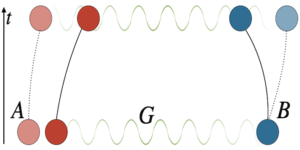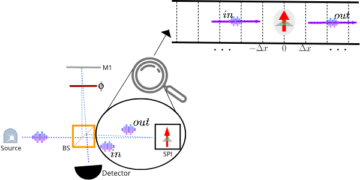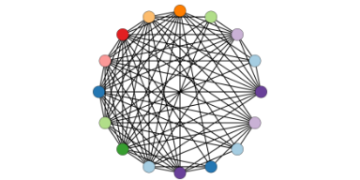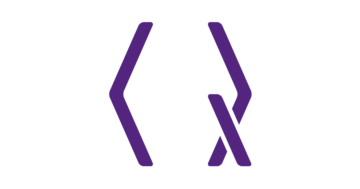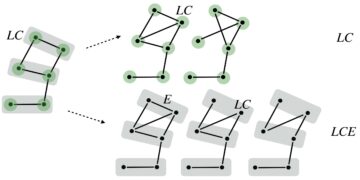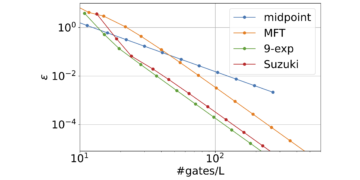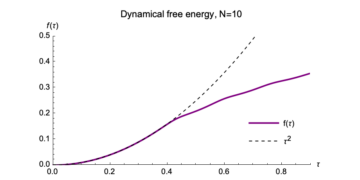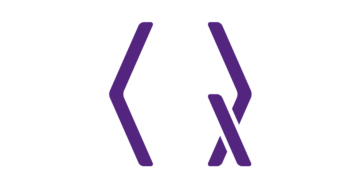1Centro di ricerca quantistica, Istituto di innovazione tecnologica, Abu Dhabi, Emirati Arabi Uniti.
2Dipartimento di Fisica, Università di Milano-Bicocca, I-20126 Milano, Italia.
3INFN – Sezione di Milano Bicocca, I-20126 Milano, Italia.
4Departament de Física Quàntica i Astrofísica e Institut de Ciències del Cosmos (ICCUB), Universitat de Barcelona, Barcellona, Spagna.
5TIF Lab, Dipartimento di Fisica, Università degli Studi di Milano, Italia
6INFN, Sezione di Milano, I-20133 Milano, Italia.
7Istituto Nazionale di Fisica Nucleare (INFN), Sezione di Roma, Roma, Italia
8Università La Sapienza di Roma, dip. di Fisica, Roma, Italia
9CERN, Dipartimento di Fisica Teorica, CH-1211 Ginevra 23, Svizzera.
10Divisione di fisica e fisica applicata, Scuola di scienze fisiche e matematiche, Nanyang Technological University, 21 Nanyang Link, Singapore 637371, Singapore.
11Centro per le tecnologie quantistiche, Università Nazionale di Singapore, Singapore.
Trovi questo documento interessante o vuoi discuterne? Scrivi o lascia un commento su SciRate.
Astratto
Presentiamo $texttt{Qibolab}$, una libreria software open source per il controllo dell'hardware quantistico integrata con il framework middleware di calcolo quantistico $texttt{Qibo}$. $texttt{Qibolab}$ fornisce il livello software necessario per eseguire automaticamente algoritmi basati su circuiti su piattaforme hardware quantistiche self-hosted personalizzate. Introduciamo una serie di oggetti progettati per fornire accesso programmatico al controllo quantistico attraverso driver orientati agli impulsi per strumenti, transpiler e algoritmi di ottimizzazione. $texttt{Qibolab}$ consente a sperimentali e sviluppatori di delegare tutti gli aspetti complessi dell'implementazione hardware alla libreria in modo che possano standardizzare l'implementazione di algoritmi di calcolo quantistico in modo estensibile e indipendente dall'hardware, utilizzando qubit superconduttori come prima tecnologia quantistica ufficialmente supportata. Per prima cosa descriviamo lo stato di tutti i componenti della libreria, quindi mostriamo esempi di configurazione di controllo per piattaforme di qubit superconduttori. Infine, presentiamo i risultati di applicazioni di successo relative ad algoritmi basati su circuiti.
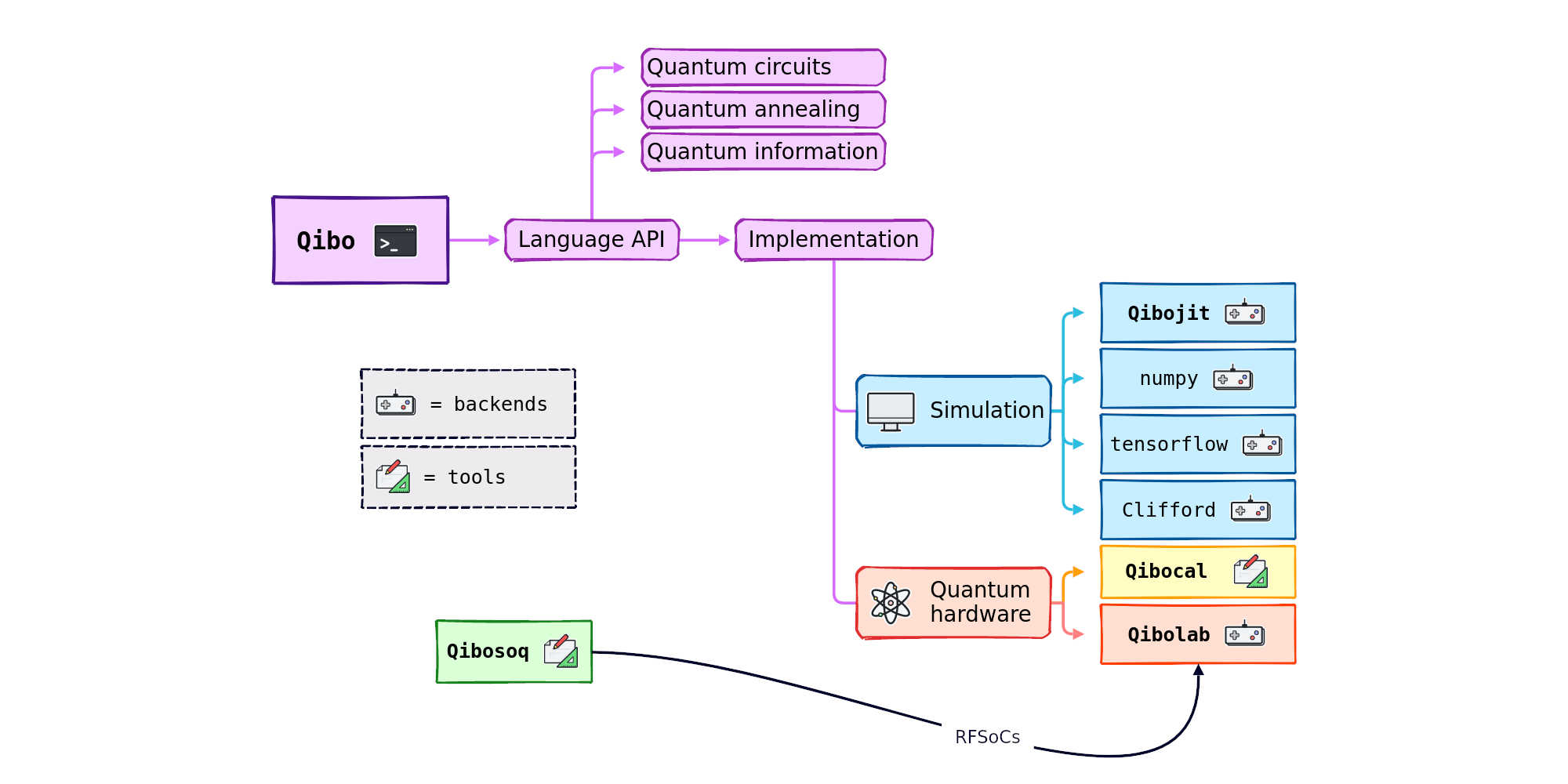
Immagine in primo piano: ecosistema software Qibo.
Riepilogo popolare
► dati BibTeX
► Riferimenti
, R. Brun e F. Rademakers, Strumenti e metodi nucleari nella ricerca fisica Sezione A: Acceleratori, spettrometri, rilevatori e apparecchiature associate 389, 81 (1997), nuove tecniche di calcolo nella ricerca fisica V.
https://doi.org/10.1016/S0168-9002(97)00048-X
, J. Alwall, R. Frederix, S. Frixione, V. Hirschi, F. Maltoni, O. Mattelaer, H.-S. Shao, T. Stelzer, P. Torrielli e M. Zaro, Journal of High Energy Physics 2014, 10.1007/jhep07(2014)079 (2014).
https:///doi.org/10.1007/jhep07(2014)079
, M. Abadi, A. Agarwal, P. Barham, E. Brevdo, Z. Chen, C. Citro, GS Corrado, A. Davis, J. Dean, M. Devin, S. Ghemawat, I. Goodfellow, A. Harp, G. Irving, M. Isard, Y. Jia, R. Jozefowicz, L. Kaiser, M. Kudlur, J. Levenberg, D. Mané, R. Monga, S. Moore, D. Murray, C. Olah, M. Schuster, J. Shlens, B. Steiner, I. Sutskever, K. Talwar, P. Tucker, V. Vanhoucke, V. Vasudevan, F. Viégas, O. Vinyals, P. Warden, M. Wattenberg, M. Wicke, Y. Yu e X. Zheng, TensorFlow: Machine learning su larga scala su sistemi eterogenei (2015), software disponibile dal tensore flusso.org.
https:///www.tensorflow.org/
, Cirq, un framework Python per creare, modificare e richiamare circuiti Noisy Intermediate Scale Quantum (NISQ) (2018).
https: / / github.com/ quantumlib / Cirq
, M. Broughton et al., Tensorflow quantum: un framework software per l'apprendimento automatico quantistico (2020).
https:///doi.org/10.48550/arXiv.2003.02989
, H. Abraham et al., Qiskit: un framework open source per l'informatica quantistica (2019).
https: / / doi.org/ 10.5281 / zenodo.2562110
, RS Smith, MJ Curtis e WJ Zeng, Un'architettura pratica di set di istruzioni quantistiche (2016).
https:///doi.org/10.48550/arXiv.1608.03355
, GG Guerreschi, J. Hogaboam, F. Baruffa e NPD Sawaya, Quantum Science and Technology 5, pp. 034007 (2020).
https: / / doi.org/ 10.1088 / 2058-9565 / ab8505
, A. Kelly, Simulazione di computer quantistici utilizzando opencl (2018).
https:///doi.org/10.48550/arXiv.1805.00988
, Gli sviluppatori di Qulacs, Qulacs (2018).
https: / / github.com/ qulacs / qulacs
, T. Jones, A. Brown, I. Bush e SC Benjamin, Scientific Reports 9, 10.1038/s41598-019-47174-9 (2019).
https://doi.org/10.1038/s41598-019-47174-9
, P. Zhang, J. Yuan e X. Lu, in Algorithms and Architectures for Parallel Processing, a cura di G. Wang, A. Zomaya, G. Martinez e K. Li (Springer International Publishing, Cham, 2015) pp. 241–256.
https://doi.org/10.1007/978-3-319-27119-4_17
, DS Steiger, T. Häner e M. Troyer, Quantum 2, 49 (2018).
https://doi.org/10.22331/q-2018-01-31-49
, Il linguaggio di programmazione Q# (2017).
https:///docs.microsoft.com/en-us/quantum/guida-utente/?view=qsharp-preview
, A. Zulehner e R. Wille, Simulazione avanzata di calcoli quantistici (2017).
https:///doi.org/10.48550/arXiv.1707.00865
, E. Pednault et al., Simulazione di circuiti quantistici pareto-efficienti utilizzando il differimento della contrazione del tensore (2017).
https:///doi.org/10.48550/arXiv.1710.05867
, S. Bravyi e D. Gosset, Physical Review Letters 116, pp. 250501 (2016).
https: / / doi.org/ 10.1103 / PhysRevLett.116.250501
, K. De Raedt et al., Computer Physics Communications 176, pp. 121 (2007).
https: / / doi.org/ 10.1016 / j.cpc.2006.08.007
, ES Fried et al., PLOS ONE 13, e0208510 (2018).
https: / / doi.org/ 10.1371 / journal.pone.0208510
, B. Villalonga et al., npj Quantum Information 5, 10.1038/s41534-019-0196-1 (2019).
https://doi.org/10.1038/s41534-019-0196-1
, X.-Z. Luo, J.-G. Liu, P. Zhang e L. Wang, Yao.jl: Framework estensibile ed efficiente per la progettazione di algoritmi quantistici (2019), [quant-ph].
https://doi.org/10.22331/q-2020-10-11-341
, V. Bergholm et al., Pennylane: Differenziazione automatica di calcoli ibridi quantistici-classici (2018), arXiv:1811.04968 [quant-ph].
arXiv: 1811.04968
, J. Doi et al., in Atti della 16a conferenza internazionale ACM sulle frontiere dell'informatica, CF '19 (Association for Computing Machinery, New York, NY, USA, 2019) p. 85–93.
https: / / doi.org/ 10.1145 / 3310273.3323053 mila
, M. Möller e M. Schalkers, in Computational Science – ICCS 2020, a cura di VV Krzhizhanovskaya, G. Závodszky, MH Lees, JJ Dongarra, PMA Sloot, S. Brissos e J. Teixeira (Springer International Publishing, Cham, 2020) pagine 451–464.
https://doi.org/10.1007/978-3-030-50433-5_35
, T. Jones e S. Benjamin, Scienza e tecnologia quantistica 5, 034012 (2020).
https: / / doi.org/ 10.1088 / 2058-9565 / ab8506
, Z.-Y. Chen et al., Science Bulletin 63, pagg. 964–971 (2018).
https: / / doi.org/ 10.1016 / j.scib.2018.06.007
, H. Bian, J. Huang, R. Dong, Y. Guo e X. Wang, in Algorithms and Architectures for Parallel Processing, a cura di M. Qiu (Springer International Publishing, 2020) pp. 111–125.
https://doi.org/10.1007/978-3-030-60239-0_8
, I. Meyerov, A. Liniov, M. Ivanchenko e S. Denisov, Simulazione della dinamica quantistica: Evoluzione degli algoritmi nel contesto hpc (2020), arXiv:2005.04681 [quant-ph].
arXiv: 2005.04681
, AA Moueddene, N. Khammassi, K. Bertels e CG Almudever, Simulazione realistica del calcolo quantistico utilizzando canali unitari e di misurazione (2020).
https: / / doi.org/ 10.1103 / PhysRevA.102.052608
, Z. Wang et al., Un simulatore di circuiti quantistici e le sue applicazioni sul supercomputer Sunway Taihulight (2020).
https: / / doi.org/ 10.1038 / s41598-020-79777-y
, JH Nielsen, M. Astafev, WH Nielsen, D. Vogel, lakhotiaharshit, A. Johnson, A. Hardal, Akshita, sohail chatoor, F. Bonabi, Liang, G. Ungaretti, S. Pauka, T. Morgan, Adriaan, P Eendebak, B. Nijholt, qSaevar, P. Eendebak, S. Droege, Samantha, J. Darulova, R. van Gulik, N. Pearson, ThorvaldLarsen e A. Corna, Qcodes/qcodes: Qcodes 0.43.0 (2024 ).
https: / / doi.org/ 10.5281 / zenodo.10459033
, M. Rol, C. Dickel, S.Asaad, N. Langford, C. Bultink, R. Sagastizabal, N. Langford, G. de Lange, X. Fu, S. de Jong, F. Luthi e W. Vlothuizen , DiCarloLab-Delft/PycQED_py3: rilascio pubblico iniziale (2016).
https: / / doi.org/ 10.5281 / zenodo.160327
, Keysight, Labber, https:///www.keysight.com/us/en/lib/software-detail/instrument-firmware-software/labber-3113052.html (2022).
https:///www.keysight.com/us/en/lib/software-detail/instrument-firmware-software/labber-3113052.html
, S. Efthymiou, S. Ramos-Calderer, C. Bravo-Prieto, A. Pérez-Salinas, a.-M. . io, . Diego Garcí, A. Garcia-Saez, JI Latorre e S. Carrazza, Scienza e tecnologia quantistica 7, 015018 (2021).
https://doi.org/10.1088/2058-9565/ac39f5
, S. Efthymiou, M. Lazzarin, A. Pasquale e S. Carrazza, Quantum 6, 814 (2022).
https://doi.org/10.22331/q-2022-09-22-814
, S. Carrazza, S. Efthymiou, M. Lazzarin e A. Pasquale, Journal of Physics: Conference Series 2438, 012148 (2023).
https://doi.org/10.1088/1742-6596/2438/1/012148
, S. Efthymiou et al., qiboteam/qibo: Qibo 0.1.12 (2023a).
https: / / doi.org/ 10.5281 / zenodo.7736837
, S. Efthymiou et al., qiboteam/qibolab: Qibolab 0.0.2 (2023b).
https: / / doi.org/ 10.5281 / zenodo.7748527
, J. Preskill, (2018a).
http:///theory.caltech.edu/~preskill/ph219/chap3_15.pdf
, A. Lui, B. Nachman, WA de Jong e CW Bauer, Phys. Rev. A 102, 012426 (2020).
https: / / doi.org/ 10.1103 / PhysRevA.102.012426
, A. Sopena, MH Gordon, G. Sierra e E. López, Scienza e tecnologia quantistica 6, 045003 (2021).
https://doi.org/10.1088/2058-9565/ac0e7a
, E. van den Berg, ZK Minev e K. Temme, Physical Review A 105, 10.1103/physreva.105.032620 (2022).
https: / / doi.org/ 10.1103 / physreva.105.032620
, D. Coppersmith, Una trasformata di Fourier approssimativa utile nella fattorizzazione quantistica (2002a).
https:///doi.org/10.48550/arXiv.quant-ph/0201067
arXiv: Quant-ph / 0201067
, A. Peruzzo et al., Nature communications 5, pp. 4213 (2014).
https: / / doi.org/ 10.1038 / ncomms5213
, A. Garcia-Saez e JI Latorre, Affrontare problemi classici difficili con autosolutori quantistici variazionali assistiti adiabaticamente (2018).
https:///doi.org/10.48550/arXiv.1806.02287
, E. Farhi, J. Goldstone e S. Gutmann, Un algoritmo di ottimizzazione approssimata quantistica (2014).
https:///doi.org/10.48550/arXiv.1411.4028
, AB Magann, KM Rudinger, MD Grace e M. Sarovar, Physical Review Letters 129, 10.1103/physrevlett.129.250502 (2022).
https: / / doi.org/ 10.1103 / physrevlett.129.250502
, C. Bravo-Prieto, J. Baglio, M. Cè, A. Francis, DM Grabowska e S. Carrazza, Quantum 6, 777 (2022).
https://doi.org/10.22331/q-2022-08-17-777
, LK Grover, Un algoritmo quantomeccanico veloce per la ricerca nei database (1996).
https:///doi.org/10.48550/arXiv.quant-ph/9605043
arXiv: Quant-ph / 9605043
, S. Hadfield, Z. Wang, BO Gorman, E. Rieffel, D. Venturelli e R. Biswas, Algorithms 12, 34 (2019).
https: / / doi.org/ 10.3390 / a12020034
, E. Farhi, J. Goldstone, S. Gutmann e M. Sipser, Calcolo quantistico mediante evoluzione adiabatica (2000).
https:///doi.org/10.48550/arXiv.quant-ph/0001106
arXiv: Quant-ph / 0001106
, Qibo: esempi di documentazione API, https:///qibo.science/qibo/stable/api-reference/index.html.
https:///qibo.science/qibo/stable/api-reference/index.html
, J. Preskill, Quantum 2, 79 (2018b).
https://doi.org/10.22331/q-2018-08-06-79
, TE Oliphant, Guida a NumPy (Trelgol, 2006).
, DE Rumelhart, GE Hinton e RJ Williams, Nature 323, 533 (1986).
https: / / doi.org/ 10.1038 / 323533a0
, SK Lam, A. Pitrou e S. Seibert, in Atti del secondo seminario sull'infrastruttura del compilatore LLVM in HPC (2015) pp. 1–6.
https: / / doi.org/ 10.1145 / 2833157.2833162 mila
, R. Okuta, Y. Unno, D. Nishino, S. Hido e C. Loomis, in Atti del workshop sui sistemi di apprendimento automatico (LearningSys) nella trentunesima conferenza annuale sui sistemi di elaborazione delle informazioni neurali (NIPS) (2017).
http:///learningsys.org/nips17/assets/papers/paper_16.pdf
, T. team di sviluppo cuQuantum, cuquantum (2023), se utilizzi questo software, citalo come di seguito.
https: / / doi.org/ 10.5281 / zenodo.7806810
, D. Coppersmith, Una trasformata di Fourier approssimativa utile nella fattorizzazione quantistica (2002b).
https:///doi.org/10.48550/arXiv.quant-ph/0201067
arXiv: Quant-ph / 0201067
, E. Bernstein e U. Vazirani, SIAM Journal on Computing 26, 1411 (1997).
https: / / doi.org/ 10.1137 / S0097539796300921
, J. Biamonte e V. Bergholm, Le reti tensoriali in poche parole (2017).
https:///doi.org/10.48550/arXiv.1708.00006
, X. Yuan, J. Sun, J. Liu, Q. Zhao e Y. Zhou, Physical Review Letters 127, 10.1103/physrevlett.127.040501 (2021).
https: / / doi.org/ 10.1103 / physrevlett.127.040501
, W. Huggins, P. Patil, B. Mitchell, KB Whaley e EM Stoudenmire, Quantum Science and Technology 4, 024001 (2019).
https: / / doi.org/ 10.1088 / 2058-9565 / aaea94
, R. Orús, Annali di fisica 349, 117 (2014).
https: / / doi.org/ 10.1016 / j.aop.2014.06.013
, J. Biamonte, Lezioni sulle reti di tensori quantistici (2020).
https:///doi.org/10.48550/arXiv.1912.10049
, F. Arute, K. Arya, R. Babbush, D. Bacon, J. Bardin, R. Barends, R. Biswas, S. Boixo, F. Brandao, D. Buell, B. Burkett, Y. Chen, J. Chen, B. Chiaro, R. Collins, W. Courtney, A. Dunsworth, E. Farhi, B. Foxen, A. Fowler, CM Gidney, M. Giustina, R. Graff, K. Guerin, S. Habegger, M Harrigan, M. Hartmann, A. Ho, MR Hoffmann, T. Huang, T. Humble, S. Isakov, E. Jeffrey, Z. Jiang, D. Kafri, K. Kechedzhi, J. Kelly, P. Klimov, S. Knysh, A. Korotkov, F. Kostritsa, D. Landhuis, M. Lindmark, E. Lucero, D. Lyakh, S. Mandrà, JR McClean, M. McEwen, A. Megrant, X. Mi, K. Michielsen , M. Mohseni, J. Mutus, O. Naaman, M. Neeley, C. Neill, MY Niu, E. Ostby, A. Petukhov, J. Platt, C. Quintana, EG Rieffel, P. Roushan, N. Rubin , D. Sank, KJ Satzinger, V. Smelyanskiy, KJ Sung, M. Trevithick, A. Vainsencher, B. Villalonga, T. White, ZJ Yao, P. Yeh, A. Zalcman, H. Neven e J. Martinis , Natura 574, 505–510 (2019).
https://doi.org/10.1038/s41586-019-1666-5
, YY Gao, MA Rol, S. Touzard e C. Wang, PRX Quantum 2, 040202 (2021).
https: / / doi.org/ 10.1103 / PRXQuantum.2.040202
, D. Leibfried, R. Blatt, C. Monroe e D. Wineland, Rev. Mod. Phys. 75, 281 (2003).
https: / / doi.org/ 10.1103 / RevModPhys.75.281
, L. Henriet, L. Beguin, A. Signoles, T. Lahaye, A. Browaeys, G.-O. Reymond e C. Jurczak, Quantum 4, 327 (2020).
https://doi.org/10.22331/q-2020-09-21-327
, J. Koch, TM Yu, J. Gambetta, AA Houck, DI Schuster, J. Majer, A. Blais, MH Devoret, SM Girvin e RJ Schoelkopf, Physical Review A 76, 10.1103/physreva.76.042319 (2007).
https: / / doi.org/ 10.1103 / physreva.76.042319
, BD Josephson, fisico. Lett. 1, 251 (1962).
https://doi.org/10.1016/0031-9163(62)91369-0
, T. Alexander, N. Kanazawa, DJ Egger, L. Capelluto, CJ Wood, A. Javadi-Abhari e D. C McKay, Quantum Science and Technology 5, 044006 (2020).
https: / / doi.org/ 10.1088 / 2058-9565 / aba404
, H. Silvério, S. Grijalva, C. Dalyac, L. Leclerc, PJ Karalekas, N. Shammah, M. Beji, L.-P. Henry e L. Henriet, Quantum 6, 629 (2022).
https://doi.org/10.22331/q-2022-01-24-629
, ZurichInstruments, https:///www.zhinst.com/others/en/quantum-computing-systems/labone-q (2023a).
https:///www.zhinst.com/others/en/quantum-computing-systems/labone-q
, L. Ella, L. Leandro, O. Wertheim, Y. Romach, R. Szmuk, Y. Knol, N. Ofek, I. Sivan e Y. Cohen, Elaborazione quantistica classica e benchmarking a livello di impulso (2023 ).
https:///doi.org/10.48550/arXiv.2303.03816
, Qblox, https:///qblox-qblox-instruments.readthedocs-hosted.com/en/master/ (2023a).
https:///qblox-qblox-instruments.readthedocs-hosted.com/it/master/
, M. Naghiloo, Introduzione alla misurazione quantistica sperimentale con qubit superconduttori (2019).
https:///doi.org/10.48550/arXiv.1904.09291
, A. Pasquale et al., qiboteam/qibocal: Qibocal 0.0.1 (2023a).
https: / / doi.org/ 10.5281 / zenodo.7662185
, A. Pasquale, S. Efthymiou, S. Ramos-Calderer, J. Wilkens, I. Roth e S. Carrazza, Verso un framework open source per eseguire la calibrazione e la caratterizzazione quantistica (2023b).
https:///doi.org/10.48550/arXiv.2303.10397
, M. Kliesch e I. Roth, PRX Quantum 2, 010201 (2021).
https: / / doi.org/ 10.1103 / PRXQuantum.2.010201
, J. Emerson, R. Alicki e K. Zyczkowski, J. Opt. B7, S347 (2005).
https://doi.org/10.1088/1464-4266/7/10/021
, E. Knill, D. Leibfried, R. Reichle, J. Britton, RB Blakestad, JD Jost, C. Langer, R. Ozeri, S. Seidelin e DJ Wineland, Physical Review A 77, 10.1103/physreva.77.012307 ( 2008).
https: / / doi.org/ 10.1103 / physreva.77.012307
, B. Lévi, CC López, J. Emerson e DG Cory, Phys. Rev.A75, 022314 (2007).
https: / / doi.org/ 10.1103 / PhysRevA.75.022314
, C. Dankert, R. Cleve, J. Emerson e E. Livine, Phys. Rev. A 80, 012304 (2009).
https: / / doi.org/ 10.1103 / PhysRevA.80.012304
, J. Helsen, I. Roth, E. Onorati, AH Werner e J. Eisert, arXiv:2010.07974 3, 020357 (2022).
https: / / doi.org/ 10.1103 / PRXQuantum.3.020357
arXiv: 2010.07974
, AP et al, In preparazione (2023).
, F. Motzoi, JM Gambetta, P. Rebentrost e FK Wilhelm, Phys. Rev. Lett. 103, 110501 (2009).
https: / / doi.org/ 10.1103 / PhysRevLett.103.110501
, J. Heinsoo, CK Andersen, A. Remm, S. Krinner, T. Walter, Y. Salathé, S. Gasparinetti, J.-C. Besse, A. Potočnik, A. Wallraff e C. Eichler, Phys. Rev. Appl. 10, 034040 (2018).
https: / / doi.org/ 10.1103 / PhysRevApplied.10.034040
, Y. Xu, G. Huang, J. Balewski, A. Morvan, K. Nowrouzi, DI Santiago, RK Naik, B. Mitchell e I. Siddiqi, ACM Transactions on Quantum Computing 4, 10.1145/3529397 (2022).
https: / / doi.org/ 10.1145 / 3529397 mila
, J. Kelly, P. O'Malley, M. Neeley, H. Neven e JM Martinis, Calibrazione fisica dei qubit su un grafico aciclico diretto (2018).
https:///doi.org/10.48550/arXiv.1803.03226
, Qibolab: Creazione della piattaforma, https:///qibo.science/qibolab/stable/tutorials/lab.html.
https:///qibo.science/qibolab/stable/tutorials/lab.html
, Qibolab: serializzazione della piattaforma, https:///qibo.science/qibolab/stable/api-reference/qibolab.html#module-qibolab.serialize.
https:///qibo.science/qibolab/stable/api-reference/qibolab.html#module-qibolab.serialize
, Qibolab: formati dei risultati, https:///qibo.science/qibolab/stable/main-documentation/qibolab.html#results.
https:///qibo.science/qibolab/stable/main-documentation/qibolab.html#results
, Qblox, https:///www.qblox.com.
https:///www.qblox.com
, QuantumMachines, https:///www.quantum-machines.co/.
https:///www.quantum-machines.co/
, ZurichInstruments, https:///www.zhinst.com/others/en/quantum-computing-systems/qccs (2023b).
https:///www.zhinst.com/others/en/quantum-computing-systems/qccs
, L. Stefanazzi, K. Treptow, N. Wilcer, C. Stoughton, C. Bradford, S. Uemura, S. Zorzetti, S. Montella, G. Cancelo, S. Sussman, A. Houck, S. Saxena, H. Arnaldi, A. Agrawal, H. Zhang, C. Ding e DI Schuster, Review of Scientific Instruments 93, 10.1063/5.0076249 (2022).
https: / / doi.org/ 10.1063 / 5.0076249 mila
, R. Carobene et al., qiboteam/qibosoq: Qibosoq 0.0.3 (2023).
https: / / doi.org/ 10.5281 / zenodo.8126172
, Qblox, https:///qblox-qblox-instruments.readthedocs-hosted.com/en/master/getting_started/product_overview.html#cluster.
https:///qblox-qblox-instruments.readthedocs-hosted.com/en/master/getting_started/product_overview.html#cluster
, Qblox, https:///qblox-qblox-instruments.readthedocs-hosted.com/en/master/cluster/qrm_rf.html (2023b).
https:///qblox-qblox-instruments.readthedocs-hosted.com/en/master/cluster/qrm_rf.html
, Qblox, https:///qblox-qblox-instruments.readthedocs-hosted.com/en/master/cluster/qcm_rf.html (2023c).
https:///qblox-qblox-instruments.readthedocs-hosted.com/en/master/cluster/qcm_rf.html
, Qblox, https:///qblox-qblox-instruments.readthedocs-hosted.com/en/master/cluster/qcm.html (2023d).
https:///qblox-qblox-instruments.readthedocs-hosted.com/en/master/cluster/qcm.html
, Qblox, https:///qblox-qblox-instruments.readthedocs-hosted.com/en/master/cluster/synchronization.html#synq.
https:///qblox-qblox-instruments.readthedocs-hosted.com/en/master/cluster/synchronization.html#synq
, Qcodes, https:///qcodes.github.io/Qcodes/ (2023).
https:///qcodes.github.io/Qcodes/
, Qblox, https:///qblox-qblox-instruments.readthedocs-hosted.com/en/master/tutorials/q1asm_tutorials.html (2023e).
https:///qblox-qblox-instruments.readthedocs-hosted.com/en/master/tutorials/q1asm_tutorials.html
, OPX+, https:///www.quantum-machines.co/products/opx/.
https:///www.quantum-machines.co/products/opx/
, ZurichInstruments, https:///www.zhinst.com/others/en/products/shfqc-qubit-controller (2023c).
https:///www.zhinst.com/others/en/products/shfqc-qubit-controller
, J. Herrmann, C. Hellings, S. Lazar, F. Pfäffli, F. Haupt, T. Thiele, DC Zanuz, GJ Norris, F. Heer, C. Eichler e A. Wallraff, Schemi di conversione della frequenza per il controllo qubit superconduttori (2022).
https:///doi.org/10.48550/arXiv.2210.02513
, ZurichInstruments, https:///www.zhinst.com/others/en/products/hdawg-arbitrary-waveform-generator (2023d).
https:///www.zhinst.com/others/en/products/hdawg-arbitrary-waveform-generator
, ZurichInstruments, https:///www.zhinst.com/others/en/products/pqsc-programmable-quantum-system-controller (2023e).
https:///www.zhinst.com/others/en/products/pqsc-programmable-quantum-system-controller
, Xilinx-(AMD), specifiche Rfsoc 4×2, https:///www.xilinx.com/support/university/xup-boards/RFSoC4x2.html (2022a).
https:///www.xilinx.com/support/university/xup-boards/RFSoC4x2.html
, Xilinx-(AMD), specifiche Zcu111, https:///www.xilinx.com/products/boards-and-kits/zcu111.html (2022b).
https:///www.xilinx.com/prodotti/schede-e-kit/zcu111.html
, Xilinx-(AMD), specifiche Zcu216, https:///www.xilinx.com/products/boards-and-kits/zcu216.html (2022c).
https:///www.xilinx.com/prodotti/schede-e-kit/zcu216.html
, PSV Naidu, Elaborazione moderna del segnale digitale (Alpha Science International, 2003).
, A. Barenco, CH Bennett, R. Cleve, DP DiVincenzo, N. Margolus, P. Shor, T. Sleator, JA Smolin e H. Weinfurter, Physical Review A 52, 3457 (1995).
https: / / doi.org/ 10.1103 / physreva.52.3457
, T. Ito, N. Kakimura, N. Kamiyama, Y. Kobayashi e Y. Okamoto, Teoria algoritmica del routing dei qubit (2023).
https:///doi.org/10.48550/arXiv.2305.02059
, S. Heng, D. Kim, S. Heng e Y. Han, nel 2022 37a conferenza tecnica internazionale su circuiti/sistemi, computer e comunicazioni (ITC-CSCC) (2022) pp. 1–3.
https:///doi.org/10.1109/ITC-CSCC55581.2022.9894863
, P. Zhu, S. Zheng, L. Wei, C. Xueyun, Z. Guan e S. Feng, Quantum Information Processing 21 (2022).
https://doi.org/10.1007/s11128-022-03698-0
, T. Itoko, R. Raymond, T. Imamichi e A. Matsuo, Ottimizzazione della mappatura dei circuiti quantistici utilizzando la trasformazione e la commutazione del gate (2019).
https:///doi.org/10.48550/arXiv.1907.02686
, G. Vidal e CM Dawson, Physical Review A 69, 10.1103/physreva.69.010301 (2004).
https: / / doi.org/ 10.1103 / physreva.69.010301
, T. Fösel, MY Niu, F. Marquardt e L. Li, Ottimizzazione del circuito quantistico con apprendimento di rinforzo profondo (2021).
https:///doi.org/10.48550/arXiv.2103.07585
, G. Li, Y. Ding e Y. Xie, Affrontare il problema della mappatura dei qubit per i dispositivi quantistici dell'era nisq (2019).
https:///doi.org/10.48550/arXiv.1809.02573
, Y. Kharkov, A. Ivanova, E. Mikhantiev e A. Kotelnikov, benchmark Arline: piattaforma di benchmarking automatizzata per compilatori quantistici (2022).
https:///doi.org/10.48550/arXiv.2202.14025
, Benchmark Qibolab, https:///github.com/qiboteam/qibolab-benchmarks/tree/v0.1.0.
https:///github.com/qiboteam/qibolab-benchmarks/tree/v0.1.0
, JF Clauser, MA Horne, A. Shimony e RA Holt, Phys. Rev. Lett. 23, 880 (1969).
https: / / doi.org/ 10.1103 / PhysRevLett.23.880
, JS Bell, Physics Physique Fizika 1, 195 (1964).
https: / / doi.org/ 10.1103 / PhysicsPhysiqueFizika.1.195
, M. Schuld, I. Sinayskiy e F. Petruccione, Contemporary Physics 56, 172 (2014).
https: / / doi.org/ 10.1080 / 00107514.2014.964942 mila
, J. Biamonte, P. Wittek, N. Pancotti, P. Rebentrost, N. Wiebe e S. Lloyd, Nature 549, 195 (2017).
https: / / doi.org/ 10.1038 / nature23474
, K. Mitarai, M. Negoro, M. Kitagawa e K. Fujii, Physical Review A 98, 10.1103/physreva.98.032309 (2018).
https: / / doi.org/ 10.1103 / physreva.98.032309
, M. Cerezo, A. Arrasmith, R. Babbush, SC Benjamin, S. Endo, K. Fujii, JR McClean, K. Mitarai, X. Yuan, L. Cincio e PJ Coles, Nature Reviews Physics 3, 625 (2021 ).
https://doi.org/10.1038/s42254-021-00348-9
, S. Wang, E. Fontana, M. Cerezo, K. Sharma, A. Sone, L. Cincio e PJ Coles, Nature Communications 12, 10.1038/s41467-021-27045-6 (2021).
https://doi.org/10.1038/s41467-021-27045-6
, A. Pérez-Salinas, J. Cruz-Martinez, AA Alhajri e S. Carrazza, Physical Review D 103, 10.1103/physrevd.103.034027 (2021).
https: / / doi.org/ 10.1103 / physrevd.103.034027
, M. Robbiati, JM Cruz-Martinez e S. Carrazza, Determinazione delle funzioni di densità di probabilità con il calcolo quantistico adiabatico (2023).
https:///doi.org/10.48550/arXiv.2303.11346
, S. Bordoni, D. Stanev, T. Santantonio e S. Giagu, Particelle 6, 297 (2023).
https:///doi.org/10.3390/particles6010016
, M. Robbiati, S. Efthymiou, A. Pasquale e S. Carrazza, Una discesa analitica quantistica di Adam attraverso la regola dello spostamento dei parametri utilizzando qibo (2022).
https:///doi.org/10.48550/arXiv.2210.10787
, RD Ball, S. Carrazza, J. Cruz-Martinez, LD Debbio, S. Forte, T. Giani, S. Iranipour, Z. Kassabov, JI Latorre, ER Nocera, RL Pearson, J. Rojo, R. Stegeman, C Schwan, M. Ubiali, C. Voisey e M. Wilson, The European Physical Journal C 82, 10.1140/epjc/s10052-022-10328-7 (2022).
https://doi.org/10.1140/epjc/s10052-022-10328-7
, A. Pérez-Salinas, A. Cervera-Lierta, E. Gil-Fuster e JI Latorre, Quantum 4, 226 (2020).
https://doi.org/10.22331/q-2020-02-06-226
, DP Kingma e J. Ba, Adam: un metodo per l'ottimizzazione stocastica (2017).
https:///doi.org/10.48550/arXiv.1412.6980
, M. Schuld, V. Bergholm, C. Gogolin, J. Izaac e N. Killoran, Physical Review A 99, 10.1103/physreva.99.032331 (2019).
https: / / doi.org/ 10.1103 / physreva.99.032331
Citato da
[1] Jorge J. Martínez de Lejarza, Leandro Cieri, Michele Grossi, Sofia Vallecorsa e Germán Rodrigo, "Integrazione del loop Feynman su un computer quantistico", arXiv: 2401.03023, (2024).
[2] Chunyang Ding, Martin Di Federico, Michael Hatridge, Andrew Houck, Sebastien Leger, Jeronimo Martinez, Connie Miao, David I. Schuster, Leandro Stefanazzi, Chris Stoughton, Sara Sussman, Ken Treptow, Sho Uemura, Neal Wilcer, Helin Zhang , Chao Zhou e Gustavo Cancelo, "Progressi sperimentali con il QICK (Quantum Instrumentation Control Kit) per l'hardware quantistico superconduttore", arXiv: 2311.17171, (2023).
[3] Alessandro D'Elia, Boulos Alfakes, Anas Alkhazaleh, Leonardo Banchi, Matteo Beretta, Stefano Carrazza, Fabio Chiarello, Daniele Di Gioacchino, Andrea Giachero, Felix Henrich, Alex Stephane Piedjou Komnang, Carlo Ligi, Giovanni Maccarrone, Massimo Macucci, Emanuele Palumbo, Andrea Pasquale, Luca Piersanti, Florent Ravaux, Alessio Rettaroli, Matteo Robbiati, Simone Tocci e Claudio Gatti, “Caratterizzazione di un Qubit Transmon in una cavità 3D per l'apprendimento automatico quantistico e il conteggio dei fotoni”, arXiv: 2402.04322, (2024).
[4] Steve Abel, Juan Carlos Criado e Michael Spannowsky, "Addestramento di reti neurali con il calcolo quantistico adiabatico universale", arXiv: 2308.13028, (2023).
[5] Matteo Robbiati, Alejandro Sopena, Andrea Papaluca e Stefano Carrazza, "Mitigazione degli errori in tempo reale per l'ottimizzazione variazionale su hardware quantistico", arXiv: 2311.05680, (2023).
[6] Edoardo Pedicillo, Andrea Pasquale e Stefano Carrazza, “Benchmarking di modelli di machine learning per la classificazione degli stati quantistici”, arXiv: 2309.07679, (2023).
Le citazioni sopra sono di ANNUNCI SAO / NASA (ultimo aggiornamento riuscito 2024-02-16 02:12:31). L'elenco potrebbe essere incompleto poiché non tutti gli editori forniscono dati di citazione adeguati e completi.
On Il servizio citato da Crossref non sono stati trovati dati su citazioni (ultimo tentativo 2024-02-16 02:12:30).
Questo documento è pubblicato in Quantum sotto il Creative Commons Attribuzione 4.0 Internazionale (CC BY 4.0) licenza. Il copyright rimane dei detentori del copyright originali come gli autori o le loro istituzioni.
- Distribuzione di contenuti basati su SEO e PR. Ricevi amplificazione oggi.
- PlatoData.Network Generativo verticale Ai. Potenzia te stesso. Accedi qui.
- PlatoAiStream. Intelligenza Web3. Conoscenza amplificata. Accedi qui.
- PlatoneESG. Carbonio, Tecnologia pulita, Energia, Ambiente, Solare, Gestione dei rifiuti. Accedi qui.
- Platone Salute. Intelligence sulle biotecnologie e sulle sperimentazioni cliniche. Accedi qui.
- Fonte: https://quantum-journal.org/papers/q-2024-02-12-1247/
- :È
- :non
- ][P
- 02
- 06
- 08
- 1
- 10
- 100
- 102
- 107
- 11
- 110
- 114
- 116
- 118
- 12
- 120
- 121
- 125
- 127
- 13
- 130
- 135
- 14
- 15%
- 16
- 16°
- 17
- 19
- 195
- 1995
- 1996
- 2%
- 20
- 2000
- 2005
- 2006
- 2008
- 2009
- 2010
- 2014
- 2015
- 2016
- 2017
- 2018
- 2019
- 2020
- 2021
- 2022
- 2023
- 2024
- 21
- 22
- 23
- 24
- 25
- 26
- 27
- 28
- 29
- 30
- 31
- 32
- 33
- 34
- 35%
- 36
- 39
- 3d
- 4
- 40
- 41
- 42
- 45
- 46
- 48
- 49
- 5
- 50
- 51
- 52
- 54
- 55
- 58
- 6
- 60
- 62
- 65
- 66
- 67
- 7
- 70
- 72
- 73
- 74
- 75
- 77
- 8
- 80
- 84
- 87
- 880
- 89
- 9
- 90
- 91
- 97
- 98
- a
- sforzi sono stati
- sopra
- abraham
- ABSTRACT
- abu
- Abu Dhabi
- acceleratori
- accesso
- ACM
- aciclico
- Adam
- indirizzamento
- Avanzate
- avanzamenti
- affiliazioni
- AL
- Alexander
- alex
- Alexander
- algoritmo
- algoritmica
- Algoritmi
- Tutti
- Alpha
- AMD
- an
- Analitico
- ed
- Andersen
- Andrea
- Andrea
- annuale
- api
- Applicazioni
- applicazioni
- applicato
- approssimativo
- architettura
- architetture
- SONO
- arya
- AS
- aspetti
- assistito
- associato
- Associazione
- At
- tentativo
- autore
- gli autori
- Automatizzata
- Automatico
- automaticamente
- disponibile
- b
- palla
- Barcellona
- BE
- Campana
- sotto
- analisi comparativa
- parametri di riferimento
- benzoino
- BIANCO
- Rompere
- pelle
- bollettino
- by
- Materiale
- carlos
- centro
- Certificazione
- canali
- chen
- chris
- circuito
- circuiti
- citando
- classificazione
- cohen
- Collins
- COM
- commento
- Popolo
- Comunicazioni
- compilatore
- completamento di una
- complesso
- componenti
- calcolo
- computazionale
- calcoli
- computer
- computer
- informatica
- Convegno
- musica
- contesto
- contrazione
- di controllo
- controllo
- copyright
- cosmo
- conteggio
- Creazione
- creazione
- costume
- dati
- Banca Dati
- David
- Davis
- de
- deep
- del
- Essa
- densità
- DEP
- Shirts Department
- deployment
- descrivere
- Design
- progettato
- determinazione
- sviluppatori
- Mercato
- team di sviluppo
- dispositivi
- Devin
- Dhabi
- Diego
- digitale
- indirizzato
- discutere
- documentazione
- dong
- driver
- dinamica
- e
- E&T
- ecosistema
- modificato
- efficiente
- Abilita
- energia
- usate
- errore
- Etere (ETH)
- europeo
- evoluzione
- Esempi
- eseguire
- sperimentale
- factoring
- FAST
- Febbraio
- Federico
- Infine
- Nome
- Nel
- formati
- Forte
- essere trovato
- Fourier
- Contesto
- Francis
- Frequenza
- da
- Frontiers
- fu
- funzioni
- GAO
- gate
- Ginevra
- giovanni
- GitHub
- gordon
- grazia
- grafico
- guida
- Hard
- Hardware
- harvard
- he
- henry
- Alta
- titolari
- hpc
- HTML
- http
- HTTPS
- huang
- umile
- IBRIDO
- ibrido quantistico-classico
- i
- if
- Immagine
- implementazione
- in
- informazioni
- Infrastruttura
- inizialmente
- Innovazione
- Istituto
- istituzioni
- strumenti
- integrato
- integrazione
- interessante
- Intermedio
- Internazionale
- introdurre
- Introduzione
- IT
- Italia
- SUO
- JavaScript
- jeffrey
- JL
- Johnson
- Jones
- rivista
- Giovanni
- Kim
- kit
- Koch
- laboratorio
- Lam
- Lingua
- larga scala
- Cognome
- strato
- apprendimento
- Lasciare
- letture
- Leggere
- li
- Biblioteca
- Licenza
- LINK
- Lista
- macchina
- machine learning
- macchinario
- mappatura
- martyn
- matematico
- max-width
- Maggio..
- McClean
- meccanico
- metodo
- metodi
- Michael
- Microsoft
- MILANO
- MILANO
- attenuazione
- modelli
- moderno
- Mese
- Morgan
- Murray
- il
- Natura
- reti
- Neurale
- reti neurali
- New
- New York
- no
- nucleare
- numpy
- guscio di noce
- NY
- oggetti
- of
- Ufficialmente
- on
- ONE
- aprire
- open source
- Software open source
- operativo
- sistema operativo
- ottimizzazione
- or
- i
- pagine
- Carta
- Parallel
- parametro
- Paul
- Pearson
- eseguire
- Fisico
- Fisica
- piattaforma
- Piattaforme
- Platone
- Platone Data Intelligence
- PlatoneDati
- per favore
- Pratico
- preparazione
- presenti
- probabilità
- Problema
- problemi
- procedimento
- lavorazione
- programmatica
- Programmazione
- fornire
- fornisce
- la percezione
- pubblicato
- editore
- editori
- editoriale
- Python
- qiskit
- Quantistico
- Computer quantistico
- computer quantistici
- calcolo quantistico
- algoritmi di calcolo quantistico
- informazione quantistica
- apprendimento automatico quantistico
- misura quantistica
- sistema operativo quantistico
- software quantistico
- tecnologia quantistica
- qubit
- qubit
- R
- tempo reale
- realistico
- Riferimenti
- insegnamento rafforzativo
- relazionato
- rilasciare
- resti
- Report
- necessario
- riparazioni
- colpevole
- Risultati
- recensioni
- Recensioni
- Roma
- instradamento
- Regola
- s
- Scala
- schemi
- di moto
- Scienze
- Scienza e Tecnologia
- SCIENZE
- scientifico
- Cerca
- Secondo
- Sezione
- Serie
- set
- flessibile.
- Sharma
- spostamento
- mostrare attraverso le sue creazioni
- siam
- Signal
- simulazione
- simulatore
- Singapore
- fabbro
- So
- Software
- Sviluppatori di software
- Spagna
- Specifiche tecniche
- Regione / Stato
- Stato dei servizi
- Steve
- di successo
- Con successo
- tale
- adatto
- Dom.
- cantato
- supercomputer
- supportato
- Svizzera
- sync.
- sistema
- SISTEMI DI TRATTAMENTO
- T
- Affronto
- team
- Consulenza
- tecniche
- tecnologico
- Tecnologie
- Tecnologia
- innovazione tecnologica
- tensorflow
- I
- loro
- poi
- teorico
- teoria
- di
- questo
- Attraverso
- Titolo
- a
- verso
- Training
- Le transazioni
- Trasformare
- Trasformazione
- UAE
- per
- universale
- Università
- aggiornato
- URL
- USA
- uso
- utile
- utilizzando
- volume
- W
- wang
- volere
- Prima
- Modo..
- we
- bianca
- Williams
- Wilson
- con
- legno
- lavori
- laboratorio
- X
- anno
- York
- Tu
- Yuan
- zefiro
- Zhang
- Zhao



